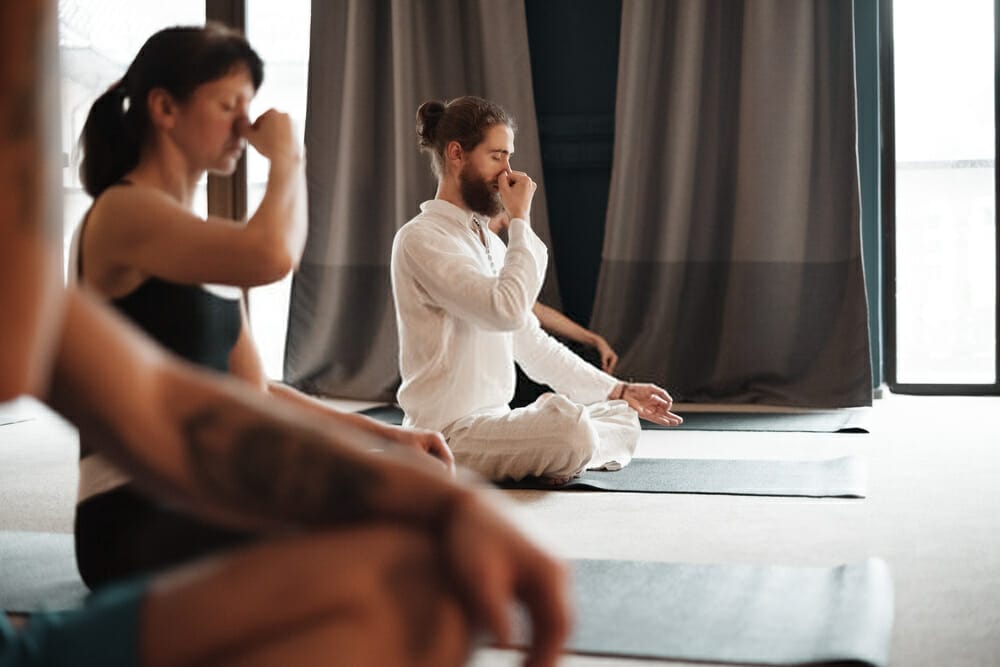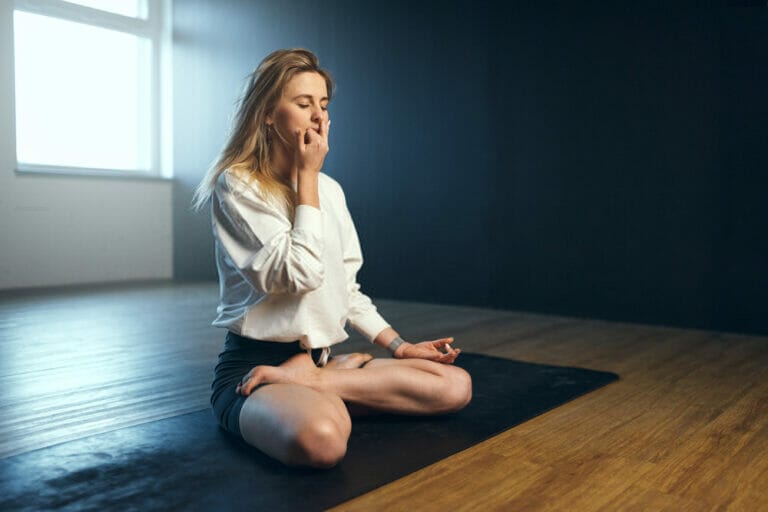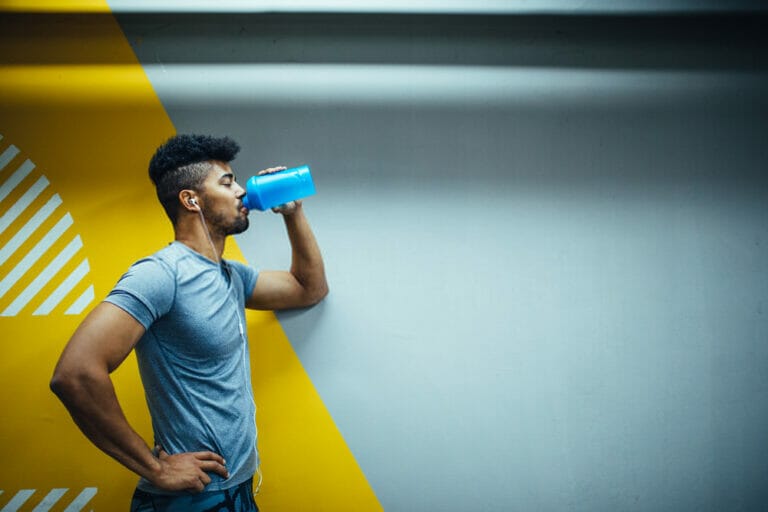Kapal Bhati Pranayama – Its Details And Steps To Do It
Many breathing exercises are beneficial for our health and well-being.
One of the most popular and effective is the Kapalbhati Pranayama. It is a straightforward breathing exercise that you can do while sitting in the lotus position.
This exercise aims to make the air enter through the nostrils and exhale through the mouth. This practice is believed to clean the respiratory tract, improve concentration, and increase oxygen in the blood.
This article will discuss the benefits of this exercise and why it is an essential component of every healthy lifestyle.
We will also discuss the correct way to perform the exercise and expect this beneficial technique.
What Is Kapalbhati Pranayama?
The name Kapalbhati is made up of two words: Kapal, which means skull, and Bhati, which means dazzling or glossy.

While many Yoga breathing techniques emphasize muscle control during inhalation, Kapalbhati promotes aggressive exhale to oxygenate the body.
The central concept is to cleanse the brain, nasal passages, sinuses, and body by exhaling brief and powerful bursts of air, eventually replenishing them with oxygen-rich blood.
Some yogis do not consider Kapalbhati genuine pranayama practice because it does not require breath retention; yet, it is highly valued among all Yogic breathing exercises.
Furthermore, Kapalbhati is important in breath training and assists persons in preparing for the practice of Bhastrika, a pranayam that involves a higher flow of oxygen to the body.
According to many Yogis, no workout compares to Kapalbhati yoga to enhance blood oxygenation and spiritual gain.
Kapalbhati technique purifies the subtle energy currents or nadis and awakens the energies along the Sushumna Nadi.
Types of Kapalbhati Pranayama
Vatakrama
Vatakarma Kapalabhati is characterized by rapid exhale through both nostrils, followed by a short and gentle inhalation.
It's identical to kapalbhati, except that exhalation is done through the mouth with kumbhaka instead of the nose (restraining breath in the nose).
Vyutkrama
Jala Neti (a form of neti – nasal cleaning procedure) is comparable to Vyutkrama Kapalbhati. This technique is smelling water from a pot through both nostrils and exhaling it through the mouth.
It aids in cleaning the nasal cavity, throat and the reduction of inflammation around the nose.
Sheetkrama
Vyutkrama Kapalbhati is the inverse procedure of Sheetkrama Kapalbhati. It entails sucking in water via the lips and exhaling it through the nose.
As a result, Sheetkrama reduces wrinkles and brightens the skin. It also cleans the mucous membrane of the nose, allowing for proper breathing.
How does it work
Kapalbhati is a self-healing technique in which the emphasis is on forcing the breath outward. When one practitioner exhales forcefully, the stomach enters, and when the stomach enters, it generates heat throughout the body.
As this pranayama is practised with devotion and dedication, the magnetic strength of Apan Vayu (air) begins climbing from the mid-spinal cord towards the skull.
It purifies the cerebellum region of the brain, and when the breath is ejected out with greater force, this filters the cerebrum Sahasrar. As a result, this Pranayama aids in the purification of the entire skull and all that it includes.
The purification process of the air flowing out of the nostrils may be strengthened by Sattvic food and drinks along with Pranayama, including Kapalbhati.
This process enhances the Kundalini’s ascent up the spine and its energetic action in the abdomen, stomach, spleen, liver, lungs, and higher brain regions.
Steps on doing Kapalbhati Pranayama

- Sit up straight with your spine erect. Place your hands on your knees, palms facing the sky.
- Take a long, deep breath in.
- Pull your stomach in as you exhale. Pull your navel in towards your spine. Do as much as you can comfortably. You can feel the abdominal muscles contract by keeping your right hand on your stomach.
- The breath pours into your lungs effortlessly as you relax your navel and abdomen.
- To complete one round of Kapal Bhati Pranayama, take 20 such breaths.
- After finishing the round, close your eyes and observe the sensations in your body.
Continue with two more rounds of Kapal Bhati Pranayama.
Tips
- Put your right hand on your stomach to feel the motions of the abdominal muscles. Maintain equal and consistent stomach pulls throughout the pranayama cycle.
- If you feel dizzy while practising kapalbhati, you are doing it too aggressively. So begin by practising with less power and more awareness.
- In the beginning, three rounds of 20 breaths are sufficient for a beginner.
- After one month of practice, raise to 5 rounds and ten breaths per week. As a result, after six weeks, you will be doing 100 breaths per round, for a total of 500 kapalbhati breaths.
Benefits
Kapalbhati Pranayama is a powerful technique that promotes deep relaxation of the nervous system. As a result, it is beneficial for mental clarity and concentration, reducing stress and anxiety.
The practice also improves the respiratory system and can prevent asthma while increasing lung capacity.
Helps in weight loss
With the help of effective Pranayama techniques, you may tone your abdominal area and stimulate weight loss.
It would be a pity if a literate individual questioned the possibility of losing fat using breathing exercises.
Allow the transfer of oxygen to do the honours, which you can keep up by being self-disciplined.
It deals with and reduces obesity.
Mental Agility
It helps in gaining mental agility by cleansing the mind along with the body. It is essential for effective learning and retention of information.
You can notice the reverse effects by taking blood pressure or diabetes medications, which leave the mind dull.
By taking responsibility for your well-being, you can work towards achieving mental clarity and focus.
Blood Circulation and Digestion
Breathing exercises, including Kapalbhati Pranayama, benefit blood circulation and digestion. The muscles enveloping the torso are engaged in these breathing techniques, which generate heat through friction from the movement of the diaphragm and other muscles.
It increases blood flow to the digestive organs and improves digestion.
Kapalabhati helps to keep your metabolism at a healthy level which eventually helps you lose weight.
In addition, it can improve appetite and has even been known to induce hunger pains.
Enhances Beauty
Who says Beauty can only be seen in external aspects, such as the face and the clothing? When it comes to having a healthy body and clear skin, you can be beautiful even if you’re not the most attractive of the lot.
It is because you're breathing correctly and taking care of your health. You look livelier and vibrant when under stress and strain, and all that rage manifests itself through your face and eyes.
Kapalabhati and other Pranayama techniques help relax your facial muscles and cleanse the internal organs for a perfect complexion.
You don't need to set aside time out of your daily routine for beauty treatment anymore. Once you clear the stress from your mind and body, it will reflect on your face, and the glow will remain. Your overall health is taken care of as well.
Stress Relief
Stress is detrimental to one’s health, both physically and mentally. It is because the body reacts adversely when subjected to excessive amounts of pressure or stress.

So it would help if you kept your mind healthy and vibrant by practising mastery over breathing techniques.
Breathing exercises help with the control of the mind. Therefore, most people who practice them are less prone to bouts of anger.
Healthy Body Organs
The lungs, the heart, and the abdominal organs are all affected by pranayama. Kapalabhati, in particular, is ideal for those who have breathing difficulties.
It is a natural way to stimulate the transfer of oxygen to all tissues and body cells.
It can help relieve symptoms of fatigue and increase energy levels. Regular practice also helps clear the respiratory tract of pollutants and bacteria, so it will help you stay healthy during the cold season.
Best for Diabetes
If you have been diagnosed with diabetes, Kapalbhati Pranayama can help you manage your blood sugar levels.
It is because it has a positive effect on the pancreas, an essential organ in the development of diabetes.
Kapalbhati Pranayama also helps improve your metabolism and digestive system. It will result in a loss of fat, which is one possible cause of Type 2 diabetes.
Promote Hair Growth
A healthy hair growth process depends on the condition of the hair and scalp. So if you take care of your hair and scalp, it will be easy for your body to take care of as well.
The best way to promote healthy hair growth is to stop using shampoo and other chemicals and start using natural products safe for the scalp. Now that's a lot easier to accomplish with Pranayama breathing exercises.
The techniques also have a positive effect on overall health through improved circulation in the blood vessels.
Boost Brain Power
There is no mystery to this one. The more rested and rested we are, the better we perform. There’s a reason many businesspeople work straight through the night and then spend the following day in a passive state.
When we aren't tired and refreshed, we perform worse than fully rested and well-nourished. The same applies to our mental processes as well.
Precautions of Kapalbhati Pranayama
- Kapalbhati should not be done on an empty stomach.
- If you have a cardiac condition, you should slow down your breathing workout. However, it shouldn’t be too difficult.
- If you are pregnant or have a menstrual cycle, avoid practising Kapalbhati.
- If you have a slipped disc or a stent, you should avoid it as well.
- Learn Kapalbhati Pranayama from a trained yoga teacher, and you should imply a health checkup.
- If you have an ulcer, do not do Kapalbhati.
- If you have respiratory problems such as asthma or bronchitis, you should use caution during breathing exercises.
- While conducting Kapalbhati Pranayama, keep your limitations in mind.
Side effects
Kapalbhati is a terrific way to strengthen the body, mind and relieve stress, but only when done in moderation. There are some adverse effects if you do it incorrectly and excessively.
- Because kapalbhati is intimately related to the stomach and respiratory systems, it relieves stress on these systems. As a result, it can cause a hernia, hydrocele, and cardiac difficulties.
Improper guiding can occasionally result in spinal abnormalities.
- Excessive strokes during kapalbhati can result in dizziness and nasal blockage.
- Excessive practice, beginning on the first day, causes dry mouth, abdominal pain, and a feeling of vomiting.
Best time to perform kapalbhati
Kapalbhati is best to perform in the morning; however, make sure you haven’t eaten anything for at least 2-3 hours before beginning Kapalbhati pranayama. If you don’t have time in the morning, try in the evening.
Drink water on an empty stomach in the morning and walk for a few minutes to ensure that the stomach is adequately flushed.
Sit upright in either of these asanas, Sukhasana, Sidhasana, or Padmasana (Lotus Pose), with both hands on your knees, and begin exhaling; a hissing sound will be produced when exhaling the breath.
Conclusion
The better we take care of our internal organs, the healthier we are. For example, if you have issues with your respiratory system or have breathing difficulties, kapalbhati pranayama is an excellent practice to help control these symptoms.
It also helps improve blood circulation in the body and can increase energy levels in people who exercise regularly.
The best time to practice Kapalbhati is the morning after getting up, but you should do it every day if you can’t make it a regular practice.
Always remember to keep a relaxed mind and infuse love, etc., before beginning kapalbhati pranayama.
Then, after doing the pranayama exercises, meditate for a few minutes to completely relax the mind and body.
FAQs
1. How many times should you perform kapalbhati?
Begin with 30 breathing rounds as a beginner and gradually advance to 200 rounds every day. Experts can repeat 1000 rounds according to their ability.
2. How much average time should you spend on kapalbhati?
Perform this pranayama on an empty stomach and leave a 30-minute gap between eating and starting this pranayama. This pranayama is best done in the morning, and you should complete at least 200 rounds at a time.
3. What is recommended to eat with kapalbhati?
Sugarcane juice or rice with milk and fresh vegetables is a good breakfast. Lately, soy and rice milk has been introduced and is also a good alternative.







